
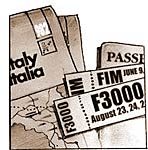
Updates from the Rest of the Racing World
Atlas F1 Magazine Writers
Advice: The points tables for most series covered by Elsewhere In Racing are available here. Individual series are linked to their corresponding points table after each report.
Peter The Great
Just 48 hours before the end of the 2004 Dakar Rally, Stephane Peterhansel was reminding the media what had happened to him twelve months earlier when he lost the lead on the penultimate special stage in Egypt. This year there was no repeat of his ill fortune, and the six time Motorcycle Dakar champion added his first car victory. He also became only the second competitor in the event's history to succesfully cross disciplines as a car and motorcycle victor, joining the rally's greatest name, Hubert Auriol.
When the rally emerged from its enforced three day rest period and started the third week of rallying, the rally returned to Mauritania, first over open plains, then a return to the soft sand dunes. Having built up over a three hour advantage over the field, the Mitsubishis rallied steadily towards the prize. Stage 14 was won by Luc Alphand in the BMW X5, while his teammate Gregoire de Mevius dropped out of the top five after losing two hours with another broken propshaft.
Into the final marathon stage in Mauritania, Masuoka won the stage by nine minutes over teammate Peterhansel, effectively ending the hopes of Jean-Louis Schlesser and Alphand in third and fourth. Stage 16 into Senegal and Dakar itself saw a first for the rally, a diesel 1-2, as Jutta Kleinschmidt led in Alphand, proving the potential of the Volkswagen Touareg. But for several instances of poor luck, Kleinschmidt could have been in the race for the final podium position.
But the rally belonged to Mitsubishi, Peterhansel winning by 49 minutes over Masuoka. In the older model Pajero, Andrea Mayer gave notice of future potential, having a trouble free run to fifth position. But for the early retirement of Miki Biasion, it was a perfect rally for Mitsubishi.
Jean-Louis Schlesser drove his Ford V6-powered self-developed buggy as hard as was possible, but third place, three hours behind Peterhansel, was all that was possible for the rally's best two wheel drive car. Josep Maria was well down the order in 19th, but finished despite the debilitating electrical problems that struck in the second week. Schlesser was advocating rule changes for 2005 to help the cause of two wheel drive buggies.
Behind Mayer, the second diesel powered car home was the Volkswagen Touareg of Bruno Saby. Kleinschmidt brought her Touareg home 17th after troubles which could have seen her retire twice in week two. After the Desert Nardos of last year, the Touareg is an obvious improvement. Kleinschmidt won Volkswagen's first stage victory in 25 years on Stage 16. VW have a long term plan for the Dakar, their commitment to the event is far from over.
While Peterhansel and Masuoka cruised along the Senegalese beaches, posing for the TV helicopters, Colin McRae scorched around the final stage, giving himself and Nissan a final stage victory to soothe the pain of their comprehensive defeat at the hands of Mitsubishi. Giniel de Villiers claimed seventh place and McRae was 20th. The Pickups had proved fast enough, but were far too fragile. Ari Vatanen retired when he crashed out of the rally on Stage 14. For the veteran Finn, who recorded his 50th Dakar Special Stage victory on Stage 4, it was merely the coup de grace on what now appears to have been his last Dakar campaign.
Thierry Magnaldi was second home in two wheel drive in his Honda V8-powered buggy ahead of the very impressive Nasser saleh Al Attiyan, who along with McRae and David Fretigne starred as rookies. The multiple Middle East Rally Champion brought his Pajero home in tenth position.
Nani Roma led the KTM fleet into Dakar with a twelve and half minute lead over Richard Sainct, as he became the first Spanish winner of the Dakar. Roma's lead, which had shrunk to around a minute on Stage 14, held firm as a string of consistent stage podiums got him the win he's been trying for since 1998. Richard Sainct was valiant in defeat, having chased hard ever since he fell heavily from his bike, requiring eight stitches to close the gash in his arm.
Veteran former winner Fabrizio Meoni was next on the big V-Twin 950cc KTM on what became his last Dakar attempt. The extra power of the bigger KTM became a source of frustration for the Italian, and while he won Stage 15, the bike could not keep tyres on the rims in the dune stages. On Stage 13 he was overtaken by the remarkable David Fretigne who went on to win his third stage of the rally on the little Yamaha 450 two wheel drive.
Fretigne, winner of the Stages 2, 3 and 13, put in an amazing ride to break the KTM stranglehold that has been on the rally for the last three years. Fretigne might have won Stage 14 as well but picked up 15 minutes in time penalties after losing his time card and was just 20 minutes short of Meoni. Fretigne was the only rider in the top 27 finishers not riding a KTM.
Vladimir Tchaguine dominated the truck classification in his Kamaz. With four stage wins by Stage 7, the field was playing catch up from a very early stage. With top three finishes on stages 14 to 16, he secured a 53 minute victory. Firdaus Kabirov came from the clouds over the final week, winning four of the final six stages to launch past the Dutch DAF and the failing Czech Tatra squad to make a Kamaz 1-2. With the third truck of Ilgizar Mardeev climbing the placing on the final week, it was an impressive 1-2-4 for the factory Russian team.
Gerardus de Rooy made the most of the Tatra's mechanical dramas on Stage 15 to consolidate third position in the DAF, 88 minutes from the defending champion. Yoshimasa Sugawara climbed into the top five in his Hino Ranger whilst Andre de Azevedo and Karel Loprais dropped to sixth and seventh over the final week, after both lost several hours on stage 15.
Result of Dakar Rally, Senegal:
Points In 2005 To Give Drivers A Second Chance
The World Rally Championship is set for a major overhaul next year with drivers allowed to score points even if they crash or stop before the final day of an event.
A spokesman for the International Automobile Federation (FIA) confirmed on Thursday that its World Rally Commission had met in London on Wednesday and unanimously approved a number of proposals.
The extraordinary meeting, chaired by FIA president Max Mosley, focused on measures to cut costs and improve the championship's popular appeal. The proposals, which will be put forward to the FIA's World Motor Sport Council at a meeting on March 24, included one outlined by Mosley last year to allow a driver to rejoin the event on the next day after retirement.
"There will therefore be 16 (three-day) events, each with its own winner, second, third etc but the world championship will be decided on the results of 48 separate days of competition," it declared.
At present only those drivers still running at the finish can score points and any competitor failing to finish a stage is barred from continuing.
"It's supposed to be something that the public watches so what's the point in not allowing that car to run on Saturday and Sunday when it could have done?," Mosley told Autosport magazine in December.
"It could have been put back onto the trailer, taken back, fixed, and then carried on for the following two days. You're never going to win a rally doing that, but there could be a points system arranged to make it viable."
Other measures concerned the pre-race reconnaissance period and the scrapping of an earlier proposal to adopt a so-called 'Mille Pistes' concept from 2005. Instead a two-day reconnaissance plus three-day rally format will be used with rally cars being used instead of ones driven by gravel crews.
Team have opposed the introduction of the Mille Pistes system, which forces them to use the regular rally cars to check out stages before competing in them in the afternoon. Organisers can choose between the formats this year.
The commission also proposed moves to ensure that World Championship events never clash with Formula One Grands Prix and that television coverage conforms to a standard schedule on Sunday afternoons.
This year's World Rally Championship has been expanded to 16 races from a previous 14 with new rounds in Japan and Mexico. The season starts in Monte Carlo this week.
Report provided by Reuters
NASCAR Rejigs Points To Boost Appeal
By Lewis Franck
NASCAR has revamped its championship points scheme in a bid to revive interest in the sport both at the track and on television. Last year's series lost its appeal early in the season as Matt Kenseth ran away with the title, prompting Tuesday's announcement of a new scheme to determine the series champion.
Cumulative points in the final 10 races of the 36-race schedule will determine the NASCAR Cup winner with the points being reset to give the leader 5,050 followed by incremental five point reductions for the remaining qualified drivers. Other drivers will continue to earn points and post-season awards but they will not be counted in the championship race.
NASCAR president Mike Helton said the scheme "will provide a better opportunity for more drivers to win the championship, creating drama and excitement throughout the entire season".
It is the first change in the points system since 1975 but the 11th since the series began in 1949.
"What we're not going to call this is a playoff, it's not a playoff, not a single elimination, it's not lose and you're out," said NASCAR chairman and CEO Brian France.
"It still has consistency (factors), there are 10 (points) races over two-and-a-half months. We think we have something that's better than a playoff."
At the end of the season drivers in the top 10 are guaranteed a point fund payout of one million dollars with the champion getting five million dollars.
IROC Series Gets A Million Dollar Boost
Officials of the International Race of Champions (IROC) announced on Thursday that the winner's purse for the four-race NASCAR stock car-style invitational series would be increased to one million dollars for this year.
Twelve drivers, in similarly prepared stock cars, will compete for the top prize, which used to be $250,000. They are chosen from the ranks of professional auto racing in the United States such as the NASCAR Nextel Cup series and Indy Racing League.
The 27th running of the series is made up of 100-mile sprint races on ovals. It starts on February 13 at the Daytona International Speedway and concludes at a yet-to-be determined date at Atlanta Motor Speedway.
Reports provided by Reuters
Honda Confirm Barros Switch For 2004
"Following the recent announcement by Alex Barros in Brazil that he is free to seek a new MotoGP ride for the 2004 season, Honda Racing Corporation today can confirm that the 33-year-old Brazilian will ride alongside Nicky Hayden ... for 2004," said a statement.
Barros, who is recovering from shoulder surgery, finished ninth in the world championship last year and his move to Honda had been widely anticipated after Rossi's unexpected switch to Yamaha at the end of last season.
The Brazilian should have no problem adapting to the Honda RCV, which has dominated the top class of grand prix racing for the last two years, as he rode it to victory in two of the last four races of the 2002 season. The 2004 season starts in South Africa on April 18.
Report provided by Reuters
![]() Rally Raid
Rally Raid
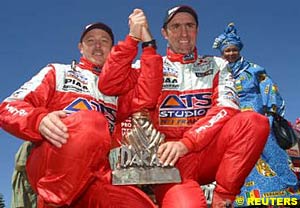 The Mitsubishi duo won the rally in the sand dunes of Mauritania. While the speed of the Nissans was greater and on the open plains the BMWs had the power, in the dunes the Pajeros were strong enough and fast enough to make the big gains.
The Mitsubishi duo won the rally in the sand dunes of Mauritania. While the speed of the Nissans was greater and on the open plains the BMWs had the power, in the dunes the Pajeros were strong enough and fast enough to make the big gains.
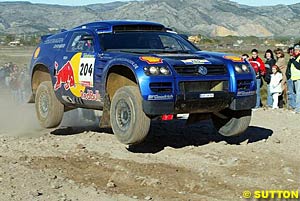 Luc Alphand won two stages in his BMW on his way to fourth place (almost four hours behind) and top diesel-powered car in a excellent effort by the privately funded team. Despite his problems, de Mevius brought his X5 home in eighth place, despite rolling in Stage 16, third in the diesel class. For the moment, any support from the factory beyond its present covert support seems unlikely.
Luc Alphand won two stages in his BMW on his way to fourth place (almost four hours behind) and top diesel-powered car in a excellent effort by the privately funded team. Despite his problems, de Mevius brought his X5 home in eighth place, despite rolling in Stage 16, third in the diesel class. For the moment, any support from the factory beyond its present covert support seems unlikely.
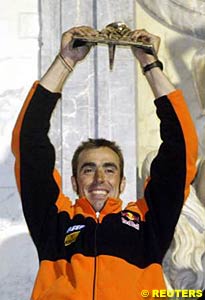 Cyril Despres's desperate chase of the bike leaders got no further than Alfie Cox's third place. Early in the third week, Despres was hauling in Roma and Sainct rapidly enough to win, but the two leaders consolidated, and even Cox started to make ground again. Despres had the lead down to under ten minutes at one point, only to miss a checkpoint and in the end was almost three quarters of an hour from the lead. Cox was five minutes back in fourth ahead of Pal Anders Ullevalseter who inherited fifth from Per-Gunnar Lundmark on Stage 15.
Cyril Despres's desperate chase of the bike leaders got no further than Alfie Cox's third place. Early in the third week, Despres was hauling in Roma and Sainct rapidly enough to win, but the two leaders consolidated, and even Cox started to make ground again. Despres had the lead down to under ten minutes at one point, only to miss a checkpoint and in the end was almost three quarters of an hour from the lead. Cox was five minutes back in fourth ahead of Pal Anders Ullevalseter who inherited fifth from Per-Gunnar Lundmark on Stage 15.
Cars
Pos Driver/Navigator Car
1. Stephane Peterhansel/Jean-Paul Cottret Mitsubishi Pajero
2. Hiroshi Masuoka/Gilles Picard Mitsubishi Pajero
3. Jean-Louis Schlesser/Jean-Marie Lurquin Schlesser-Ford
4. Luc Alphand/Henri Magne BMW X5
5. Andrea Mayer/Andreas Schulz Mitsubishi Pajero
6. Bruno Saby/Matthew Stevenson Volkswagen Touareg
7. Giniel de Villiers/Francois Jordaan Nissan Pickup
8. Gregoire de Mevius/Alain Guehennec BMW X5
9. Thierry Magnaldi/Didier Legal Honda Buggy
10. Nasser saleh Al Attiyan/Marc Bartholome Mitsubishi Pajero
Motorcycles
Pos Rider Bike
1. Nani Roma KTM 660 LC4
2. Richard Sainct KTM 660 LC4
3. Cyril Despres KTM 660 LC4
4. Alfie Cox KTM 660 Rallye
5. Pal Anders Ullevalseter KTM 660 Rallye
6. Fabrizio Meoni KTM 950 LC8
7. David Fretigne Yamaha 450 WR 2WD
8. Carlo de Gavardo KTM 660 Rallye
9. Francois Flick KTM 660 Rallye
10. Jacek Czachor KTM 660 Rallye
Trucks
Pos Driver/Crew Truck
1. Vladimir Tchaguine/S.Yakoubov/S.Savostine Kamaz 4911
2. Firdaus Kabirov/A.Belyaev/D.Kamalov Kamaz 4911
3. Gerardus de Rooy/T.Colsoul/A.Slaats DAF CF 75
4. Igizar Mardeev/S.Girya/E.Kupriyanov Kamaz 4911
5. Yoshimasa Sugawara/S.Suzuki/T.Sugawara Hino Ranger
6. Andre de Azevedo/T.Tomecek/J.Martinec Tatra T 815
7. Karel Loprais/J.Kalina/P.Gilar Tatra T 815
8. Hans Bekx/P.Flipsen/P.Blom DAF CF 75
9. Hans Stacey/T.Van Genugten/E.Chevaillier DAF CF 75
10. Peter Reif/G.Pichlbauer/C.Leidl MAN L90
![]() Rally
Rally
 A summary of the meeting seen by Reuters proposed awarding points in the 10-8-6-5-4-3-2-1 format on each day of competition.
A summary of the meeting seen by Reuters proposed awarding points in the 10-8-6-5-4-3-2-1 format on each day of competition.
![]() NASCAR
NASCAR
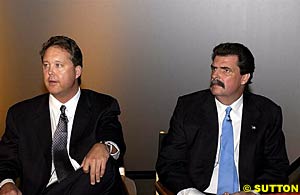 In the 'Chase for the Championship' only the top 10 drivers in the points standings after the 26th race - plus any within 400 points of the then leader - can become the champion. The winners of the 36 races will get 180 points instead of 175.
In the 'Chase for the Championship' only the top 10 drivers in the points standings after the 26th race - plus any within 400 points of the then leader - can become the champion. The winners of the 36 races will get 180 points instead of 175.
![]() MotoGP
MotoGP
 Brazilian Alex Barros will switch from Yamaha to race for Honda in MotoGP next season, replacing Italy's world champion Valentino Rossi, the Japanese manufacturer said on Tuesday.
Brazilian Alex Barros will switch from Yamaha to race for Honda in MotoGP next season, replacing Italy's world champion Valentino Rossi, the Japanese manufacturer said on Tuesday.
![]() Upcoming Events Calendar
Upcoming Events Calendar
Please Contact Us for permission to republish this or any other material from Atlas F1.
|
Volume 10, Issue 3
Articles
A Farewell to Arms?
Technical Analysis: Toyota TF104
Technical Analysis: Jaguar R5
Interview with Ron Tauranac
2004 Countdown: Facts & Stats
Columns
The Fuel Stop
The F1 Trivia Quiz
On the Road
Elsewhere in Racing
> Homepage |